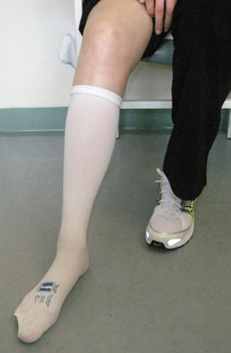Any patient who is bed-bound, unable to walk unaided or likely to spend a substantial proportion of the day in bed or in a chair for 3 days or more is at a higher risk for a ‘clot’ (or Venous Thromboembolism).
The most important things that you can do to prevent a clot are…
- Keep well hydrated
- Keep your feet and toes moving- heel toe exercises or circle your feet if you cannot move around
- Stretch regularly- Avoid long periods of staying still in the one place
- Wear Loose-fitted clothing
Those at risk of suffering a venous thromboembolism include individuals with active cancer, over 60 years of age, recent admission to an intensive care unit, dehydration, known personal risk of abnormal clotting or a first-degree relative, obesity, (body mass index>30kg/m2), use of hormone replacement therapy, use of estrogen-containing therapy, inflamed varicose veins, one or more significant medical co-morbidities (like heart disease, lung problems, diabetes, inflammatory conditions).
Some of these conditions pose a higher risk for a venous thromboembolism than others. If you have concerns about any of these, please raise them with your doctor so that you can be assessed and treated accordingly.
- Ref: NICE guidelines Jan 2010. Venous thromboembolism: reducing the risk.
Stockings
 Thrombo-embolic deterrent (or TED) stockings are commonly prescribed for patients in hospital. They are fitted based on the size of the leg and the patient is shown how to use them. In case you have forgotten, here are a few pointers…
Thrombo-embolic deterrent (or TED) stockings are commonly prescribed for patients in hospital. They are fitted based on the size of the leg and the patient is shown how to use them. In case you have forgotten, here are a few pointers…
Wear the stockings during the day AND the night while you have a significantly decreased mobility. It is generally advised that you wear the stockings for approximately 6 weeks after your operation, but clarify this when you visit the orthopedic clinic.
Remove the stockings daily and inspect the skin for any pressure sores or areas of irritation- especially where the bone is close to the skin
Do not allow the stocking to crease or fold over. This can remove the benefits of wearing the stocking.